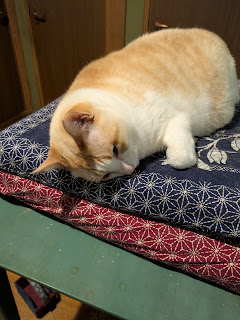I'm amazed at how different my cats are. Each one of my nine cats has its own unique character. From being a bully, to a sneak thief, and a love bug.
The longer I have had the cats, the more I'm amazed by them.
I remember when they were just kittens, reading somewhere that only cats and giraffes walk by moving their legs on the same side of their body. And yes I did spend a day watching the cats walk to see if this was really true!
Here are some more interesting facts about cats.
1. Cats can taste the air: They use a special organ called the Jacobson's organ, which is on the roof of their mouth, to smell things by slightly opening their mouths, often resulting in the "Flehmen response," that funny face they pull after smelling your socks!
2. Purring doesn't just mean they're happy: Cats also purr when they're stressed, hurt, or sick. This is thought to be a way for them to relax themselves and may even help them heal.
3. Whiskers measure space: Cats use their whiskers to judge the width of spaces and decide whether they can squeeze through. Their bodies are wider than their whiskers! Be careful of "Whisker Fatigue", their whiskers get overstimulated when touching food or water bowls. Shallow bowls, so the whiskers are outside of the bowl, are better.
4. Cat's eye lenses don't adjust like ours: They rely on dilating and constricting their pupils to regulate light, giving them exceptional vision in low light.
5. Kneading could date back to kittenhood: When cats “make biscuits,” it’s thought to mimic kneading their mother’s belly to stimulate milk flow—some say it’s also a sign of contentment.
6. They’re lactose intolerant: Contrary to popular belief, most adult cats can’t digest milk properly. It may irritate their stomachs!
7. Cats are master nappers, sleeping anywhere from 12 to 16 hours per day to conserve energy. They sleep for about 70% of their lives.
8. Their back paws are less flexible: Although a cat's front paws are extremely dexterous, their back paws are more rigid and meant to spring and exert power during jumps.
9. Cats can make hundreds of sounds: compared to dogs, who typically have about 10, cats have up to 100 distinct vocalizations. Most of these sounds are made at night, at least that is my experience.
10. Their grooming practices serve a purpose: In addition to maintaining a clean appearance, grooming aids in temperature regulation, promotes circulation, and reduces stress.
I'm really amazed by these creatures!
But having cats is not as easy as I thought it would be.
Coming soon:
Litterbox woes and expensive food!
 |
| Just three of my cats, being cute! |










.jpg)
.JPG)


.jpg)







.jpg)